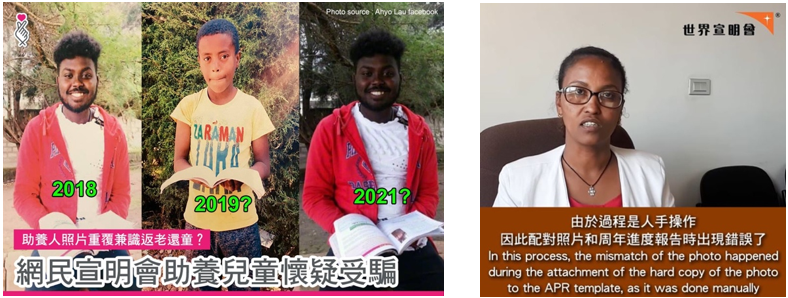World Vision – An Ethical Paradox

Lai Ho Ting Kevin
Donations are the key source of income for many charities. Recently in Hong Kong, many international charities are experiencing a significant downfall in charitable contribution. For example, Oxfam’s donation revenue has plummeted by 18% in 2020 (ON CC, 2020). Donors has become more meticulous when choosing which organization they are donating to; particularly, Charities’ brand image and trustworthiness are now in question. Thanks to its recent controversy and questionable marketing tactics, World Vision has set a bad example for us to take as a cautionary tale.
The controversy began with a post made by Ms. Lau, a child sponsor on social media earlier this year. In the post, Ms. Lau shared a few pictures together with the child sponsorship report she received from World Vision. Upon reviewing the previous reports Ms. Lau realized that the photos attached to the sponsorship report was identical to the one she received in 2018 (ON CC, 2021). This has caused Ms. Lau to question whether the person pictured is really her sponsored child. Shocked by the story, many began to challenge the organization’s credibility. Although World Vision later posted a video on its social media claiming that the photo was a simple mistake, many were not convinced (HK01, 2021). The phrase “World Vision, terminate child sponsorship” has become the top 5 World Vision related search phrase on Google HK even till today.

This is not the first time World Vision has been accused of lying to its donors. In fact, World Vision’s advertising strategy has been in question for an awfully long time. In World Vision’s advertising video, Africa was often portrayed as a rural region with nothing but trash and muddy water. Children in Africa were described and shown as famished, sick and thirsty kids in need of help (World Vision, 2020). Although there’s no doubt that some places in Africa are still in need of support, World Vision has been cherrypicking what to portray in their campaigns. According to Global Citizen, one in three Africans are now defined as ‘middle class’ and the numbers are still growing (Global Citizens, 2018). Donors in Hong Kong has also shared that their sponsored children were not as poor as World Vision claimed in their advertisement. World Vision has deliberately chosen to only show its donors the worst and poorest part of Africa to exaggerate the country’s poverty problems. This questionable marketing tactics has raised ethical concerns regarding the organization.

Like many other charities, World Vision has chosen to take an emotional approach when promoting to its donors. World Vision used an empathy appeal in its advertisement, in which the advertisement tried to evoke the emotion of empathy and understanding towards the African children in need, helping the donors to picture the problems faced by them in a more personal way and become more emotionally attached. This high level of emotional attachment cannot be achieved without a convincing and emotionally provoking story (Spiralytics, 2020) Customers love hearing stories that they can empathize with. World Vision tries to artificially create such a story by exaggerating the poverty problems in Africa, making it easier for them to use the story as powerful leverage. However, creating these “fake” stories is like playing with fire. Once the story is deemed as fake or insincere by its audience, the product or the campaign will collapse together with the story.
The child sponsorship campaign was particularly popular among donors as it gives them a sense of emotional attachment with the sponsored children. Donors are promised that the donations will be used to support one specific child and donors can build and cultivate a friendship and witness their growth. Making the donation even more personal and emotionally bonded than a normal one-off donation. However, if the story itself isn’t built on honest and solid grounds, nothing can and should grow out from it. As the moderator between the sponsor and the sponsored, it’s crucial for World Vision to uphold an honest and truthful image for donors to comfortably entrust their donations to the organization. However, with the recent controversies and overly exaggerated advertisements, World Vision is having a tough time in rebuilding this image. Marketers must take this example as a forewarning and remember – Honesty is the Best Policy.
Reference:
Global Citizens, Debunking 15 common myths and misconceptions About africa. (2018). Retrieved from https://www.globalcitizen.org/en/content/africans-are-all-poor-and-15-other-myths/
ON CC, 政Whats噏:助養兒童照片重複疑欺騙 宣明會為造成混淆致歉. (n.d.). Retrieved from https://hk.on.cc/hk/bkn/cnt/news/20210131/bkn-20210131220424220-0131_00822_001.html
ON CC, 疫情打擊經濟及投資環境 慈善機構收入重挫. (n.d.). Retrieved from https://hk.on.cc/hk/bkn/cnt/news/20201219/bkn-20201219105655383-1219_00822_001.html
Spiralytics. (2020, October 20). Emotional marketing: What it is and how it works. Retrieved from https://www.spiralytics.com/blog/emotional-marketing-what-it-is-and-how-it-works/
Worldvisionhk. (2020, September 28). Cheru’s journey. Retrieved from https://www.youtube.com/watch?v=HMuiCqyt6FA
朱利安. (2021, February 05). 宣明會為助養童照重複風波再解畫:人為錯貼 網民:錯足5年?. Retrieved from https://www.hk01.com/%E7%86%B1%E7%88%86%E8%A9%B1%E9%A1%8C/583920/%E5%AE%A3%E6%98%8E%E6%9C%83%E7%82%BA%E5%8A%A9%E9%A4%8A%E7%AB%A5%E7%85%A7%E9%87%8D%E8%A4%87%E9%A2%A8%E6%B3%A2%E5%86%8D%E8%A7%A3%E7%95%AB-%E4%BA%BA%E7%82%BA%E9%8C%AF%E8%B2%BC-%E7%B6%B2%E6%B0%91-%E9%8C%AF%E8%B6%B35%E5%B9%B4#media_id=6266147
